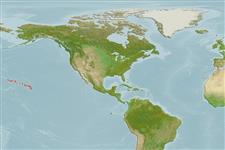>
Ovalentaria/misc (Various families in series Ovalentaria) >
Pomacentridae (Damselfishes) > Chrominae
Etymology: Dascyllus: Greek, daskillys, -on = a kind of fish (Ref. 45335).
More on author: Gill.
Environment: milieu / climate zone / depth range / distribution range
Ecologie
marien rifbewoner; standvastig; diepte 1 - 50 m (Ref. 7247). Tropical; 30°N - 15°N
Eastern Central Pacific: Hawaiian Islands and Johnston Island.
Grootte / Gewicht / Leeftijd
Maturity: Lm ? range ? - ? cm
Max length : 13.0 cm TL mannelijk / geslacht onbekend; (Ref. 9710)
Korte beschrijving
Determinatiesleutels | Morfologie | Morfometrie
Dorsale stekels (totaal) : 12; Dorsale zachte stralen (totaal) : 15 - 16; Anale stekels: 2; Anale zachte stralen: 15 - 16. Closely related D. trimaculatus, which does not occur in the Hawaiian Islands and Johnston Island.
Adults are found in very shallow, protected water, over coral and rocky bottoms. Young often sheltering among the branches of Pocillopora; occasionally commensal with the anemone Marcanthia cookei (Ref. 9710). Benthopelagic (Ref. 58302). Peak spawning from May to August. Age-at-maturity estimated at one year. Feed on zooplankton, benthic invertebrates, and algae (Ref. 9710). Oviparous, distinct pairing during breeding (Ref. 205). Eggs are demersal and adhere to the substrate (Ref. 205). Males guard and aerate the eggs (Ref. 205). Have been reared in captivity (Ref. 35412).
Levenscyclus en paargedrag
Maturities | Voortplanting | Spawnings | Egg(s) | Fecundities | Larven
Oviparous, distinct pairing during breeding (Ref. 205). Eggs are demersal and adhere to the substrate (Ref. 205). Males guard and aerate the eggs (Ref. 205). While protogyny was originally proposed for this species, recent studies confirmed gonochorism in the form of non-functional hermaphroditism (Ref. 103751).
Allen, G.R., 1991. Damselfishes of the world. Mergus Publishers, Melle, Germany. 271 p. (Ref. 7247)
Status op de Rode Lijst van het IUCN (Ref. 130435)
Gevaar voor de mens
Harmless
Gebruik door de mens
Visserij: commercieel; Aquarium: Commercieel
Tools
Speciale rapporten
Download XML
Internetbronnen
Estimates based on models
Preferred temperature (Ref.
123201): 24.2 - 25.9, mean 25.1 °C (based on 57 cells).
Fylogenetische diversiteitsindex (Ref.
82804): PD
50 = 0.5005 [Uniqueness, from 0.5 = low to 2.0 = high].
Bayesian length-weight: a=0.02089 (0.00940 - 0.04644), b=2.98 (2.80 - 3.16), in cm total length, based on LWR estimates for this (Sub)family-body shape (Ref.
93245).
Trofisch niveau (Ref.
69278): 3.1 ±0.3 se; based on diet studies.
Weerstandsvermogen (Ref.
120179): Hoog, minimale populatieverdubbelingstijd minder dan 15 maanden (Preliminary K or Fecundity.).
Fishing Vulnerability (Ref.
59153): Low vulnerability (10 of 100).
Nutrients (Ref.
124155): Calcium = 131 [68, 222] mg/100g; Iron = 1.15 [0.65, 1.98] mg/100g; Protein = 18.3 [17.0, 19.5] %; Omega3 = 0.119 [0.065, 0.219] g/100g; Selenium = 40 [19, 83] μg/100g; VitaminA = 62.9 [18.1, 229.5] μg/100g; Zinc = 1.67 [1.07, 2.47] mg/100g (wet weight);
